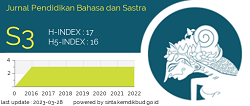The Representation of Body Image and Self-Acceptance of The Main Character in 45 Pounds (More or Less) By K.A Barson
Abstract
Keywords
Full Text:
PDFReferences
Alves, C. D. B. (2017). Influence of Media on Self Objectification, Body Image, and Rape Myths Acceptance Among College Students. Thesis. Brazil: Universidade Federal de Santa Catarina.
Armitage, C. J. (2012). Evidence that self-affirmation reduces body dissatisfaction by basing self-esteem on domains other than body weight and shape. Journal of Child Psychology and Psychiatry, 53(1), 81-88.
Barson, K. (2013). 45 Pounds More or Less. Penguin Group.
Barson, K. (2022). Biography of K.A Barson. K.A Barson.
Belinda, W. S. (2019). The Representation of Female Body Size Standard In Jemimma J By Jane Green. Skripsi. Jember University.
Bennett, A. (2021). The Art of Body Acceptance: Strengthen Your Relationship with Yourself Through Therapeutic Creative Exercises. United States: Page Street Publishing.
Blaxter et al., (2006). How to Research. New York: Open University Press.
Brickman, P., and Bulman, R. J. (1977). Pleasure and pain in social comparison. In J. M. Suls and R. L. Miller (Eds.). Social comparison processes: Theoretical and empirical perspectives. 149–186
Bridgers, K. A. (2016). More Than Skin Deep: An Examination Of The Negative Effects of More Than Skin Deep: An Examination Of The Negative Effects of Advertising On Women Advertising On Women. https://egrove.olemiss.edu/hon_thesis
Della, W. (2021). Body Image and Self Esteem: Meta-Analysis Study). Jurnal Psibernetika 14(2), 105-110.
Dingemans, A. E., Bruna, M. J., & van Furth, E. F. (2002). Binge eating disorder: A review. International Journal of Obesity 26(3): 299–307.
Fajriah, S. N. (2016). Representation of Gender Discrimination Experienced by The Female Main Characters under Taliban Regime in Deborah Elli's The Breadwinner. Skripsi. Jember: Fakultas Ilmu Budaya Universitas Jember.
Fennell, M. (2009). Overcoming Low Self-esteem: A Self-help Guide Using Cognitive Behavioral Techniques. UK: Robinson.
Ganesan, S. R. (2018). Are Body Image Issues Affecting Our Adolescent? A Cross-sectional Study Among College Going Adolescent Girl. Indian Journal of Community Medicine, 42-46.
Hall, S. (1997). Representation: Cultural Representations and Signifying Practices. UK: Sage Publications.
Hanifa, S. (2016). The Representasion of Beauty Discourse in Scott Westerfeld’s Uglies Series. Skripsi. Jember: Fakultas Ilmu Budaya Universitas Jember.
Holmqvist, K., & Frisén, A. 2010. Body dissatisfaction across cultures: Findings and research problems. European Eating Disorders Review: The Professional Journal of the Eating Disorders Association 18(2): 133-146.
Jones, D. C. (2001). Social comparison and body image: Attractiveness comparisons to models and peers among adolescent girls and boys. Sex Roles: A Journal of Research 45(9): 645–664.
Krystal, Arthur. (2014). Harpers Magazine Online. https://harpers.org/archive/2014/03/whatisliterature/
Kusumaningtyas, D. N. (2019). Body Dissatisfaction Pada Wanita Dewasa Awal yang Mengalami Obesitas. Psikoborneo 7(3), 466-475.
Leonard, K. C. (2020). The Impact of Social Media Body Challenes on Youths Body Image. Thesis: North Dakota State University.
Levine, M. (2012). Media Influences on Female Body Image. Encyclopedia of Body Image and Human Appearance. 540-546.
McClendon, G. H. (2018). Envy in Politics. United Kingdom: Princeton University Press.
Pakki, S. S. (2018). Issues Related to Body Image in Young Adult Women. Saudi Journal of Humanities and Social Sciences (SJHSS), 250-254.
Rosida, I., and Saputri, D. Y. (2019). Self-Love and Self-Acceptance: Redefining Ideal Beauty Through its Representation in Scars to Your Beautiful. LITERA 18(3): 395–412.
Sepúlveda, A. R., & Calado, M. (2012). Westernization: The Role of Mass Media on Body Image and Eating Disorders. www.intechopen.com
Siswoaribowo, A. (2020). Penerapan Self Affirmation Terhadap Penurunan Body Dissatisfaction pada Remaja Akhir. Jurnal ILKES (Jurnal Ilmu Kesehatan), 285-295.
Swami, V. (2015). Cultural Influences on Body Size Ideals: Unpacking The Impact of Westernization and Modernization. European Psychologist 20(1): 44–51.
Wakefield, J. C. (2015). Sadness or Depression? International Perspectives on the Depression Epidemic and Its Meaning. Netherland: Springer Netherlands.
DOI: https://doi.org/10.17509/bs_jpbsp.v24i1.72245
Refbacks
- There are currently no refbacks.
Copyright (c) 2024 Jurnal Pendidikan Bahasa dan Sastra
p-ISSN 1412-0712 | e-ISSN 2527-8312
JPBS is published by:
Fakultas Pendidikan Bahasa dan Sastra (Faculty of Language and Literature Education), Universitas Pendidikan Indonesia,
in cooperation with
TEFLIN, and APPBIPA


